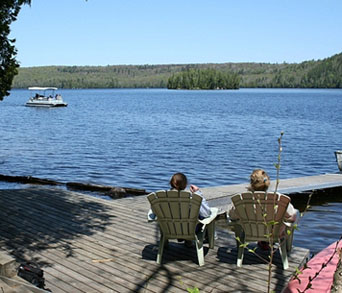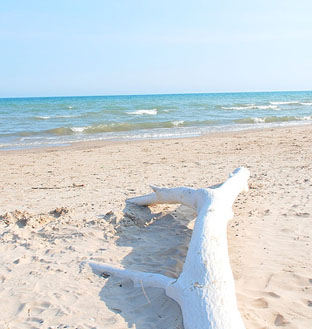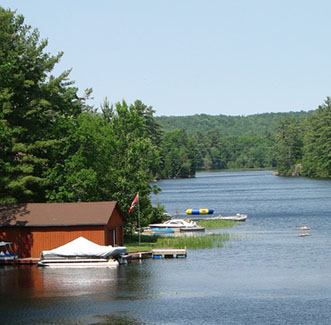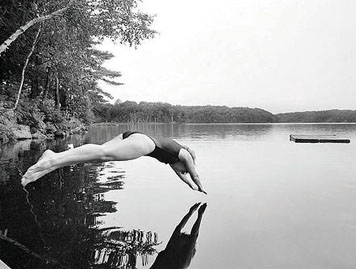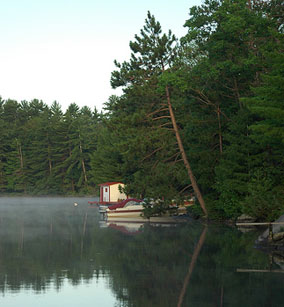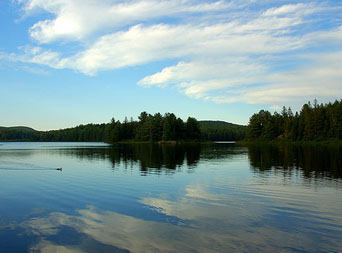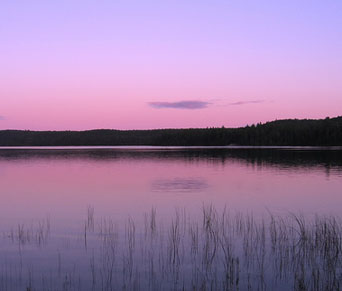Let’s not call it “Simcoe Day” .. Ontario is a bigger place in a better Canada now
Aug 2nd, 2010 | By Randall White | Category: In BriefSleeping in a cottage boathouse built by a long-deceased uncle this August civic holiday weekend has prompted some meditations on the varying accomplishments of various generations – and the importance of deciding which ones are most worth remembering today.
My uncle’s day job was in an office in the city. But, like my father and other uncles (and mothers and aunts for that matter), he built such things as cottages, boats, and boathouses, in what is still the more or less adjacent northern wilderness. In the early morning light, with the haunting call of the loon as background, I studied the solid symmetry of 2x4s, spruce-board siding, and plywood (on the roof). And it occurred to me that no one of my own generation in my larger family – virtually every member of which is now at least close to the official status of senior citizen – has built anything so impressive as a cottage, boat, or boathouse, with their own hands.
We have other accomplishments that eluded our predecessors, no doubt. (I do not, of course, have the space here to elaborate further.) But I think these different accomplishments of earlier generations are still worth remembering and even somehow celebrating today.
I would also extend this proposition to, eg: the earlier generations who built the log farmhouses you can still occasionally see on your way from the city to the wilderness; the various generations who lived in other parts of the global village and did intriguing things there, in spite of much difficulty etc; and certainly to the even earlier generations who built the ancient local dwellings and made the stone tools and pottery that regional archaeologists so like to dig up in the 21st century.
I would not personally, however, extend any admiration of such past accomplishments to the likes of John Graves Simcoe, first lieutenant governor of the old colonial British North American Province of Upper Canada. And I find it sad and discouraging that the Toronto Star has run an editorial headed “Let’s call it Simcoe Day,” which urges: “Today is Simcoe Day in Toronto, a holiday named in honour of the first lieutenant-governor of Upper Canada, as Ontario used to be known. But in most of the rest of the province, today has the exceedingly dull moniker of ‘civic holiday.’ It is a wasted opportunity to celebrate our history … for the rest of the province [too], let it be called Simcoe Day.”
My own reaction to all this is: good grief, no, no, no! The local lionization of John Graves Simcoe, whose mind, as one historian has put it, was “like a toy train, in continual brisk movement about the same circumference,” has always been an ideologically inspired plot, that has held both Ontario and its capital city back. We ought to be moving in the opposite direction, and stop calling the nicely enough named August civic holiday Simcoe Day, even in Toronto.
1. The Star’s case ..
The Star puts its case for Simcoe in two short paragraphs:
“John Graves Simcoe deserves to be celebrated. A veteran of the American Revolutionary War, he left his stamp all over the province in just four years as lieutenant-governor in the 1790s. He moved the capital from Niagara to Toronto (then called York). He started up Yonge and Dundas Sts. as major north/south and east/west thoroughfares. He banned the importation of slaves. He introduced a judicial system, based on English common law.
“He has his critics, to be sure. They point to his desire to implant a British-style aristocracy here and to make the Church of England the established church of the province. But all historical figures have warts.”
2. Simcoe’s four years .. just visiting …
My own first objection to this kind of proposal turns around the phrase “in just four years.” That is the full length of time Simcoe actually resided in what is now called Ontario. And the present-day Stephen Harper Conservative epithet “just visiting” applies to John Graves Simcoe, 1792—1796, much more than to Michael Ignatieff in 2010.
Simcoe saw his brief time in Upper Canada as just rungs on the ladder he aspired to climb as a British imperial official. After he left he served as “governor of Santo Domingo [Dominican Republic] and later commander of the Western District in England. Appointed commander in chief for India in 1806, he died before he could take up the position.”
Simcoe was committed to the future of a British empire that has now fallen, not to the future of what we now know as Ontario and Canada. And what we now know by its more ancient aboriginal name of Toronto, he had renamed the Town of York, after a member of the British royal family.
(Joseph Brant or Thayendanegea, leader of the Six Nations Iroquois loyalists in the Grand River Valley, aptly quipped on the first lieutenant governor’s departure: “Simcoe has done a great deal for this province: he has changed the name of every place in it.” Yet another case in point is what we now call Lake Simcoe, which Simcoe allegedly named “after his father.” In more ancient days it had been Lac Taronto, and then Lac aux Claies.)
3. Capital city, road building, banning slavery, and English common law
Simcoe moved the capital of Upper Canada from Niagara (which he had renamed Newark) to his new Town of York on only a temporary basis. He planned for the permanent capital to be located in what is now the city of London, Ontario. (And guess what that was named after, on the La Tranche River which Simcoe renamed the Thames?) Like a great many of Simcoe’s allegedly important and influential plans, this never happened (although the city name of London – unofficial capital of southwestern Ontario – has survived).
Similarly, the Star’s claims for the importance of Simcoe’s early road building seem to me exaggerated. His north-south projection of Yonge Street in the 1790s just followed the ancient route of the “Toronto Passage,” in the French and Indian fur trade of the preceding century and a half. And as the historian S.R. Mealing has urged: “It was only with the subsequent projection of the Danforth Road in 1799 [after Simcoe’s departure from Upper Canada] that his [road] system” acquired its later logic.
The notion that Simcoe “banned the importation of slaves” into the new British Province of Upper Canada is, I think, another half-truth – about which the full truth is seldom told, in Canada today at any rate. In fact, the July 1793 act of the Upper Canada legislature “ to prevent the further introduction of SLAVES, and to limit the Term of Contracts for SERVITUDE within this Province” was a more or less direct descendant of a March 1780 “Act for the Gradual Abolition of Slavery” in the Pennsylvania legislature. (The essential thrust of this same Pennsylvania act was subsequently adopted by “four other states and a Canadian province – Connecticut …Â Rhode Island …Â New York …Â New Jersey … and Upper Canada.”)
It also seems to me whimsical at best to celebrate John Graves Simcoe because he “introduced a judicial system, based on English common law” in what is now Ontario. The new Province of Upper Canada to which Simcoe was sent was a British colony. A judicial system based on English common law would have been introduced by whoever British imperial officials in London (England) had appointed first lieutenant governor. The essential parameters of the new colony in this respect had already been established by the British parliament’s Constitutional Act of 1791 (with which Simcoe had very little to do).
4. The last straw: Simcoe’s crusade against “the spirit of democratic subversion”
To me the biggest problem with unduly honouring John Graves Simcoe nowadays is not just “his desire to implant a British-style aristocracy here and to make the Church of England the established church of the province.” What makes him so unattractive, beyond the four mere Upper Canadian years of his mind “like a toy train, in continual brisk movement about the same circumference,” is not just that “all historical figures have warts.”
Simcoe wanted to “implant a British-style aristocracy here and to make the Church of England the established church of the province” because he believed quite passionately in a conception of politics and society that the great majority of the people of Ontario today would find altogether unacceptable. To start with, as S.R. Mealing has also noted, the “political faith” that Simcoe did try to instill in the new British province west of the Ottawa River, in the last decade of the 18th century, “was thoroughly tory.”
Especially with the new “late loyalist” migrants from the new United States that Simcoe’s land policies helped attract, this throughly tory political faith was only ever adhered to by a minority in the new Upper Canada. And even this minority lost the influence it did wield in the earlier 19th century, in the wake of the Upper Canadian Rebellion of 1837 and the achievement of so-called “responsible government” (or what we might now see as at least the beginnings of our early parliamentary democracy in Ontario) in 1848.
According to our Constitution Act 1982, eg, Canada today is “a free and democratic society.” Insofar as he had any real interest in a Canadian (as opposed to the British imperial) future, Simcoe would find this a seminal disappointment. He saw the old tory struggle of his own day against “the spirit of democratic subversion” as crucial. He believed in a “civilized subordination” of the mass of the people. He believed that “nothing is more essential than to profess Correct Opinions, unless to possess a correct Acquaintance.”
Speaking for myself, in any event, I do not want to be part of any society of the early 21st century that in any way officially honours the kinds of retrogressive old tory political values of the late 18th century which John Graves Simcoe’s toy mind did its best to propagate – even if his more impressive wife has left an interesting account of their short life in early British Upper Canada (and if his young son Frank still has a Toronto subway station named after him).
There has lately been, I also think it is reasonable to recognize, a vague revival of respect for the old “thoroughly tory … political faith” of an earlier British North America, that Simcoe is still sometimes seen to stand for – linked (perhaps even a bit strangely?) with the relative success of the Harper Conservative minority government in Ottawa (which is to some extent linked in turn with the resurgence of the tea-party right and so forth in Barack Obama’s America?). In the depths of my own political naivety, however, I am at least a little surprised to see the Toronto Star editorializing in support of all that!
Randall White is the author of Ontario 1610—1985: A Political and Economic History and Ontario Since 1985.
